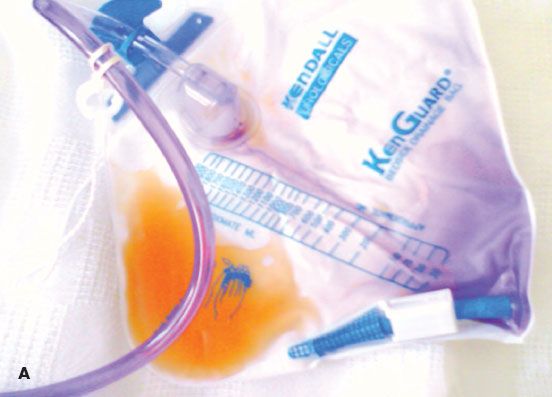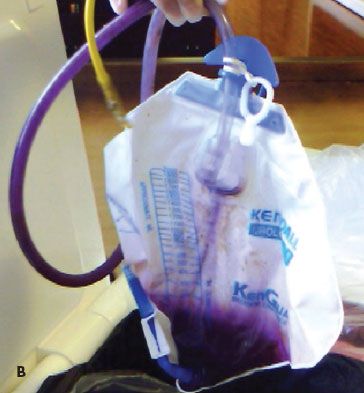Purple Urine Bag Syndrome
The purple-stained urine bags and tubing of 2 elderly patients are shown here. Neither patient received urine-discoloring medications.
The purple-stained urine bags and tubing of 2 elderly patients are shown here. Neither patient received urine-discoloring medications.
After a urinary catheter was placed in an 85-year-old woman who was receiving hospice care, purple discoloration of the tubing and the urine bag developed (A). The patient had metastatic breast cancer associated with malnutrition, dehydration, recurrent urinary tract infection (UTI), and chronic opiate-related constipation and nausea. Urinalysis revealed ketones, positive nitrite, 1 to 3 white blood cells per high-power field, 4+ bacteria, and normal pH; urine culture grew more than 100,000 colony-forming units/mL of Escherichia coli and Morganella morganii. The patient was treated for the infection.

Following the transfer of an 82-year-old man with end-stage dementia to an inpatient hospice, his urinary catheter and bag displayed purple staining (B). Investigation was refused because of the family’s request for strictly palliative care.

Purple urine bag syndrome is associated with UTI in catheterized patients, usually elderly women with significant comorbidities.1,2 Although the syndrome is rare, a prevalence as high as 9.8% has been reported among patients in long-term–care facilities.2,3 Alkaline urine and dehydration are common cofactors.2
Like most frail elderly persons with UTI, affected patients are often asymptomatic.4 Gram-negative bacterial strains that possess sulphatase or phosphatase cause the conversion of indican, a tryptophan metabolite, into indirubin (red) and indigo (blue), which produce the urinary pigments.1,2 The catheter drainage system is progressively stained from red to violet by the pigments, while the urine itself is not grossly discolored. The rarity of purple urine bag syndrome, despite the high prevalence of UTI, may signify a lack of these enzymes in other bacteria of the same species.
Discoloration of urine collection systems is uncommon and may indicate significant underlying pathology. Awareness of this unique presentation can help identify gram-negative UTI in a patient population with otherwise classically vague, delayed, or absent symptoms.
References:
REFERENCES:
1. Ribeiro JP, Marcelino P, Marum S, et al. Case report: purple urine bag syndrome. Crit Care. 2004;8:R137.
2. Harun NS, Nainar SK, Chong VH. Purple urine bag syndrome: a rare and interesting phenomenon. South Med J. 2007;100:1048-1050.
3. Schneiderman H. Purple urine bags syndrome: another complication of chronic urethral catheterization. Consultant. 2006;46:787-792.
4. Su FH, Chung SY, Chen MH, et al. Case analysis of purple urine-bag syndrome at a long-term care service in a community hospital. Chang Gung Med J. 2005;28: 636-642.